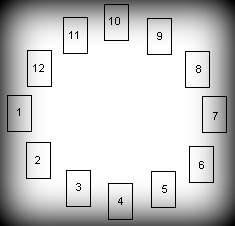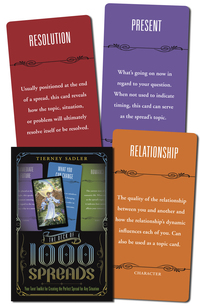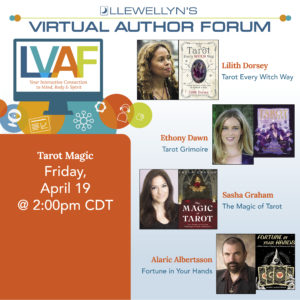Time to Listen to Your Intuition
Over a decade ago I was feeling frustrated over seeing the way most Westerners thought about Tantra. If you’re like most people, Tantra is “that sex stuff.” Or perhaps you know a bit more about it and thought that it was all about sacred sexuality and extending periods of sexual bliss. In fact, Traditional Tantra consists of some of the oldest, continually practiced Pagan traditions in the world. To say that Tantra is just about sex is like saying Wicca is just about the Great Rite or that the Bugatti Veyron Super Sport, the worlds fastest production car, is just about its gas cap.
There really is so much more to Wicca, to the Bugatti, and to Tantra. The question in my mind was, “What could I do to make people more aware of the breadth of Traditional Tantra?”
My mind went back to an old story about the Tarot cards. Supposedly, some wise people knew that a great deal of spiritual wisdom would be lost in the coming centuries. To protect that wisdom, they hid the knowledge within a tool—a deck of cards—that could be used for gambling. These people realized that knowledge may come and go but gambling was here to stay. So I thought I’d design a Tarot deck based upon the ancient concept of what I now call “Real Tantra.” This is not to say that other concepts presented as Tantra aren’t real, only that there is a form of Tantra that is much older and more complete.
My Tantric Tarot
So I started out designing the concepts behind a Tarot deck with the symbolism of Traditional Tantra and that was compatible with the concepts presented on the Rider-Waite-Smith deck. I was surprised at how easily and obviously everything fell together. But something was wrong.
One of the basic concepts of Traditional Tantra is known as Svecchachara: (pronounced “s’vek-cha-kar-uh”), which means, “The path of doing one’s own Will.” Some readers will see the similarity between this ancient Sanskrit word and Aleister Crowley’s Thelemic concept, “Do what thou wilt shall be the whole of the Law.” However, there is a difference. The Thelemic concept doesn’t mean “do what you want.” Rather, it means you should discover your True Will and do just that. Your True Will is your direction in life and will be in complete harmony with the universe and the “will” of the Divine. In some ways, it’s actually limiting as it is added in Crowley’s The Book of the Law (I:42), “thou hast no right but to do thy will.” Svecchachara, however, means that you are free to do whatever you want, but you are responsible for whatever you do. There are no limitations, but as per the law of karma, the universe will respond to what you do, positively if you do things that are positive, negatively if you do things that are negative. This is a combination of ultimate freedom combined with ultimate personal responsibility.
What was wrong with my concept of a Tantric Tarot, then, was not the card designs themselves, but rather, the strict limitations placed on the way the cards fall in a Tarot layout or spread. A spread gave context to the meaning of each card, but it also limited the card that fell in a particular position to being focused on one element. What if you needed some other concepts? How would you even know what other concepts should be brought into a reading?

TAROT HOROSCOPE SPREAD
The meaning of each card is modified by the context of the position of the card in the spread.
Trust Your Intuition
There are two major ways to interpret Tarot cards. The first is to memorize meanings of the cards. The second is to look at the image on the cards and use your intuition to determine the meaning. Personally, I believe in blending the two systems. Debunkers and pseudo-skeptics will tell you that a reading is usually so general that it could apply to anyone. However, even a general meaning—for example, you need to trust your intuition more—may appear in one reading and not in another. Why? Why is important for one person to hear a “general meaning” and not another person? The answer, I believe, is that this so-called “general meaning” needs to be heard by one person and not another. It is only superficially general. In practice it is highly specific. [And to those who don’t know, Tarot readings can become far more specific than just such a general meaning.]
There have been many times, when doing Tarot readings, that I felt additional information was needed. I would add, according to my intuition, extra cards to the reading, cards that would give extra information. There is no “Tarot Police” saying you can’t do that. So I started thinking, “What if I could add extra cards for extra information whenever I wanted?” Unfortunately, there was still a problem. The positions in a Tarot spread add context to the meaning of each card. How could I add more context to the extra cards?
After thinking about this for some time, I came up with a solution: a second deck of cards. But rather than being like additional Tarot cards, these would be contextual cards. For example, the last card in a reading often has the contextual meaning of “Final Outcome.” The first position often relates to the issue at hand. Another position would relate to hidden influences that the person wouldn’t otherwise know. I could add a bunch of cards that would add context such as the positions in a spread. This secondary deck could be added to create an extra layout that would give context to additional cards in the same way the positions in a spread add context.
And then it struck me. Here was the key to liberating Tarot readings! One entire deck of contextual cards. It could be mixed and put out forming a spread that would be unique for every Tarot reading. This would finally free the Tarot from the constraints and limitations of their use with predetermined layouts. This would be perfect for a truly Tantric Tarot.
The Design
It quickly became clear that the design of the Context Cards would have to be as well thought out as that of a Tarot deck. However, they would also have to be bigger in size. This way you could shuffle the Context Cards, lay them out, then place the actual Tarot on top of them. My plan was that these Context Cards could be used with the Tantric Tarot but also could be used with any Tarot deck.
But there was one problem. Although I’m a whiz as a designer who can take original designs and modify them or adapt them to other uses, I’m not a fine artist at all. I had the concepts, but not the original images. By chance, I discovered an artist who was intrigued by the concept and wanted to work with me on it. His first designs were absolutely breathtaking.
And then it all fell apart. I had some problems with my health and was incommunicado for several months. My hard drive broke down and I lost all of my email and addresses. I had to change internet providers and no longer had my same email. The brilliant artist couldn’t contact me. I had no way to contact him. Life came in the way of what I thought was a great idea. I put it aside and didn’t even think about it for years.
The Miracle of Creation
Several people lay claim to the invention of motion pictures, although Edison usually gets credit. Marconi gets credit for the invention of the radio, but the U.S. courts later determined that credit should actually go to Tesla. The Wright brothers are given credit for having the first powered, heavier-than-air vehicle, but there are others who could claim that they accomplished this before the Wrights.
When good ideas come about, creation is not limited to one person. The miracle of creation is that if people tune into their intuitions, they can tap into the same source as another creator.
That’s why I was absolutely delighted to see that someone else had tapped into the same source as I had once seen. The result is The Deck of 1000 Spreads by Tierney Sadler. If my idea was good, then her’s is utterly brilliant!
Ms. Sadler had created an amazing contextual deck. It allows you to design your own spreads. Each oversized, color-coded card features a spread position (such as “situation” or “outcome”) and a description of this position. You can mix and match the cards to create an entirely original and customized spread for any Tarot reading imaginable. Alternatively, you can begin with a classic spread and use this deck to modify it. This is so far beyond my concept that I am both delighted and totally enthused. In fact, the only disagreement I have with the deck is with the name: it doesn’t limit you to 1000 spreads; crafting an infinite array of spreads with this groundbreaking system is easy.
The color coding divides the deck into five areas including timing, outcomes, influences, people, and themes. You can pick from these areas to design your own reading. You can randomly select from these areas or have the person you’re reading from select from the different colored sections to design a reading that is entirely unique. The possibilities and permutations are literally endless, and it will work with any Tarot deck.
If you are just beginning with the Tarot or are a professional, I strongly urge you to consider adding this deck. It doesn’t replace any Tarot deck you currently use, it simply expands upon and improves what you’re already doing.
Listen to Your Intuition
Even if I had listened to my intuition and pushed ahead with my idea years ago, there is no way it would have been as good as The Deck of 1000 Spreads. I was focused too much on other things. As a result, I’m very glad that Ms. Sadler created this wonderful addition to the Tarot.
I wonder, however, what might have happened if I had followed my intuition at that time. I’ll never know. And as we enter Spring, 2013, I urge you to listen to your intuition. When you come up with an idea, follow it through to the end. Our intuitions are far more powerful than we may think.












[…] Read the full article […]